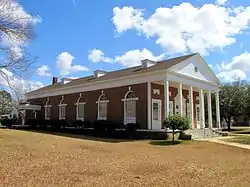Lincoln Normal School
The Lincoln Normal School, originally Lincoln School and later reorganized as State Normal School and University for the Education of Colored Teachers and Students, was a historic African American school expanded to include a Normal School in Marion, Alabama. Its roots went back to a Union Army soldier who remained in Marion after the end of the Civil War to teach newly freed African Americans. His efforts proved successful and in 1867 the school was incorporated with the support of African Americans from the surrounding Perry County. Founded less than two years after the end of the Civil War as the Lincoln Normal School in Marion, Alabama, it is one of the oldest HBCUs in the United States. Nine ex-slaves, Joey Pinch, Thomas Speed, Nickolas Dale, James Childs, Thomas Lee, John Freeman, Nathan Levert, David Harris, and Alexander H. Curtis, made up the first Board of Trustees. Under their guidance, the black and white community of Marion raised five hundred dollars to buy land for the school's campus. The money to build the school building came from the American Missionary Association (AMA). In 1868, school trustees sought the assistance of the American Missionary Association (AMA) for help with day-to-day operation of the school. The AMA supplied teachers and financial support.
Phillips Memorial Auditorium | |
 Phillips Memorial Auditorium, one of only a few campus buildings still standing | |
  | |
| Location | Lincoln Ave. and Lee St., Marion, Alabama |
|---|---|
| Coordinates | 32°37′32″N 87°19′45″W |
| Area | 0.1 acres (0.040 ha) |
| Built | 1937 |
| Architectural style | Classical Revival |
| NRHP reference No. | 88003243[1] |
| Significant dates | |
| Added to NRHP | February 13, 1990 |
| Designated ARLH | February 19, 1988 |
Teacher Training
In 1870, the school expanded to include teacher training and for a time became known as the Lincoln Normal University for Teachers. The program primarily focused on training African American high school graduates to become teachers. In 1885, Lincoln School was voted the top school for freed slaves in the south.[2] On July 26, 1878, William Burns Paterson left Tullibody Academy to accept the Presidency of the State Normal School and University for Colored Students and Teachers in Marion, Alabama.[3] In 1887 fire destroyed many of the campus buildings. As a result, the teacher training function was relocated to Montgomery where it became Alabama State University.
Faculty
The school was led by several principals, most notably Miss Mary Elizabeth Phillips. During her tenure from 1896 to 1927 both the campus and student body expanded. In 1939, alumni and friends constructed Phillips Memorial Auditorium in her honor.
Other notable faculty included Cecil and Fran Thomas who were instrumental in establishing a choral program at the school. Under their direction, choirs from the school toured across the Southeast and Midwest.[4]
Legacy and Reputation
Lincoln School became well known for graduating a high proportion of students who went on to attain advanced degrees, a remarkable achievement for any school but more particularly for a segregated high school in rural Alabama.[5][6]
The school closed in 1970, when it was consolidated with the newly built and racially integrated Marion High School. One of the few buildings remaining on the campus site is the Phillips Memorial Auditorium, now on the National Register of Historic Places and the Alabama Register of Landmarks and Heritage. The Lincoln High School Gymnasium was also added to the Alabama Register on February 29, 2005.
Notable alumni
- Coretta Scott King, civil rights activist and wife of Martin Luther King Jr.
- Edythe Scott Bagley, educator, and civil rights activist
- William R. Pettiford, Birmingham minister and banker
- Jean Childs, wife of civil rights activist Andrew Young
- Odith Thelma Patton, mother of Bishop T. D. Jakes
References
- "National Register Information System". National Register of Historic Places. National Park Service. March 13, 2009.
- See, Curtis, Nancy C., Black Heritage Sites: An African American Odyssey and Finder's Guide,(Nancy Curtis: 1996) p. 25, found online at https://books.google.com/books?id=Rk7NPRm_nB0C&pg=PA25&dq=lincoln+normal+school+marion+alabama#v=onepage&q=lincoln%20normal%20school%20marion%20alabama&f=false
- Sherer, Robert G. (1930). "William Burns Paterson: "Pioneer as well as Apostle of Negro Education in Alabama". The Alabama historical quarterly. 36 (2: summer 1974): 134. Retrieved 10 July 2017.
- See footnote at, The Papers of Martin Luther King Jr., Birth of a New Age, December 1955-December 1956, Clayborne Carson, editor, (University of California Press, 1996), at p. 28, found online at https://books.google.com/books?id=GkHrnFzEykwC&pg=RA5-PA28-IA1&dq=cecil+and+fran+thomas+lincoln+school+marion+alabama#v=onepage&q=cecil%20and%20fran%20thomas%20lincoln%20school%20marion%20alabama&f=false
- See, The Crisis, an official publication of the NAACP, Vol. 79-80, p. 156, 1972. Noted educator and scholar Horace Mann Bond attributed the inordinately high number of advanced degrees to the quality of education offered by Lincoln School. See online at, https://books.google.com/books?id=kH_XAAAAMAAJ&q=lincoln+school+marion+alabama+horace+mann+bond&dq=lincoln+school+marion+alabama+horace+mann+bond
- See also, Phillips, M.E., Lincoln Industrial School, Marion, Alabama, The American Missionary, January 1922, p. 19. Found online at https://books.google.com/books?id=uxfPAAAAMAAJ&pg=RA1-PA19&dq=lincoln+school+marion+alabama&lr=#v=onepage&q=lincoln%20school%20marion%20alabama&f=false
Further reading
- Lincoln Normal School tribute site
- Bailey, Richard. Neither Carpetbaggers Nor Scalawags: Black Officeholders during the Reconstruction of Alabama 1867–1878.
- Childs, Idella J. (1976) "Lincoln Normal School"
- History of the Baptists in Perry County
- Lincoln Normal School Scrapbooks, 1910s-1920s, The A. S. Williams III Americana Collection, University Libraries Division of Special Collections, The University of Alabama (digitized content)